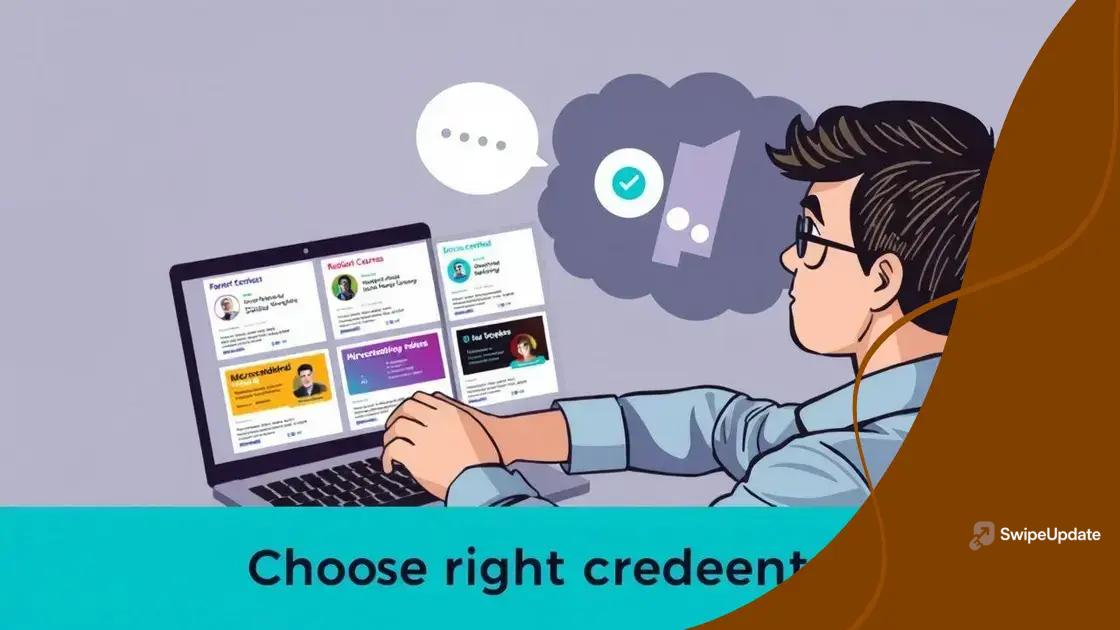Microcredentials and digital badges: unlock your potential

Microcredentials are focused certifications that validate specific skills, while digital badges provide visual proof of achievements, both gaining recognition in the professional world for their role in enhancing career opportunities.
Microcredentials and digital badges are transforming how we view education and skills. Have you ever wondered how these tools can elevate your career? Let’s dive into how they work and their potential.
Understanding microcredentials and digital badges
Understanding microcredentials and digital badges is essential in today’s education landscape. They provide a new way to highlight skills and achievements beyond traditional degrees.
These digital credentials signify your expertise in specific areas. They are often awarded after completing a course or skill training. Microcredentials can be a game-changer for many learners, offering them a way to gain recognition for their skills.
Key Features of Microcredentials
Microcredentials are not just certificates; they are more focused and specific. Key features include:
- Targeted learning outcomes
- Flexibility to learn at your own pace
- Visibility in the job market
- Digital format for easy sharing
Many organizations value digital badges because they provide verifiable proof of your skills. Badges can showcase everything from language mastery to software proficiency. They’re often backed by assessments that ensure credibility.
The Role of Digital Badges
Digital badges help employers identify the right candidates quickly. They make it simpler to understand what skills you have acquired.
As technology advances, the value of microcredentials is rising. Employers are looking for evidence of continuous learning and specific skill sets. Using badges in your resume can set you apart from the competition.
By verifying your skills with microcredentials, you open doors to new opportunities. They not only enhance your resume but provide a structured pathway for your professional development.
The benefits of earning microcredentials
There are many benefits of earning microcredentials. These digital qualifications can significantly enhance both your career and learning journey.
One major advantage is that they provide targeted learning opportunities. With microcredentials, you can focus on specific skills that employers are looking for. This specialization can set you apart from other candidates.
Career Advancement
Employers increasingly value microcredentials. They recognize that these badges demonstrate your commitment to learning and professional development. Here’s how they can help advance your career:
- Increased job opportunities
- Greater earning potential
- Improved chances for promotions
- Stronger professional network
When you showcase your microcredentials, you signal to employers that you have up-to-date skills. This is particularly important in rapidly changing industries.
Flexible Learning Options
Another benefit is the flexibility offered by microcredential programs. Many are available online, allowing you to learn at your own pace. You can choose what fits into your schedule without the rigid constraints of traditional schooling.
Moreover, microcredentials are often more affordable than full degree programs. This makes learning accessible to a broader audience. With a mix of practical experience and theoretical knowledge, they create well-rounded professionals ready to tackle job demands.
Lastly, earning microcredentials can foster a sense of accomplishment. It is rewarding to earn recognition for your efforts and growth. This added motivation can inspire you to pursue further education and skill development.
How to choose the right microcredential

Choosing the right microcredential is crucial for your career development. With many options available, it’s important to find one that aligns with your goals and interests.
Start by identifying your career aspirations. Do you want to improve your skills in a specific area or transition to a new field? Having clear objectives will guide your selection process.
Consider Industry Demand
It’s essential to choose microcredentials that are valued in your industry. Research which skills employers are currently seeking. Look for badges that represent skills in high demand, as this can enhance your job prospects.
- Check job postings for required skills.
- Follow industry news related to emerging technologies.
- Ask professionals in your field for their input.
By aligning your microcredential with industry needs, you increase your chance of being recognized by potential employers.
Evaluate Course Content
Another important factor is the content of the course offering the microcredential. Review the curriculum to ensure that it covers essential topics and skills.
Engage with the course format as well. Some prefer hands-on learning, while others may thrive in theoretical settings. Choose a program that complements your learning style for the best experience.
Additionally, verify the credibility of the issuing organization. A well-regarded institution can offer more validation for your skills, making your microcredential more impactful.
Remember to assess the duration and cost of the program too. Finding a balance between your budget and timeline is essential. Flexible online options are often available, which can help you fit learning into a busy schedule.
Real-world examples of digital badges
Real-world examples of digital badges show how versatile and effective they can be in various fields. Many organizations use these badges to recognize skills and achievements.
For instance, tech companies often award digital badges for completing training programs in specific software or programming languages. This practice helps individuals stand out, especially in a competitive job market.
Educational Institutions
Schools and universities are increasingly adopting digital badges. They provide a way for students to demonstrate their proficiencies. Students can earn badges for various accomplishments, such as:
- Completing a specific course
- Participating in extracurricular activities
- Achieving high grades in challenging subjects
These badges can be shared on resumes or social media profiles, showcasing students’ skills to potential employers.
Non-Profits and Community Programs
Non-profit organizations also utilize digital badges to recognize community service and skill development. By earning these badges, participants can highlight their commitment to personal growth and community involvement.
Another great example is Mozilla’s Open Badges initiative. This program allows organizations to create, issue, and share badges across various platforms. It encourages learners to gain skills in a way that is recognized by multiple institutions.
Digital badges not only validate skills but also help individuals track their learning journeys. In many respects, they serve as a badge of honor, demonstrating dedication and achievement in a visual format.
Future trends in microcredentials
The future of microcredentials looks promising as the demand for skill-focused learning continues to grow. Many industries are moving towards recognizing non-traditional forms of education.
One emerging trend is the integration of microcredentials into traditional educational systems. Schools and universities are beginning to offer these alongside degrees. This helps students combine formal education with practical skills.
Personalized Learning Paths
Another significant trend is the rise of personalized learning paths. Educational platforms are starting to tailor microcredential programs to fit individual needs and career goals. This customization allows learners to focus on their specific interests while still developing valuable skills.
- Adaptive learning technologies will enhance experiences.
- Data analytics can identify skills gaps.
- Personal interests will shape microcredential options.
With these personalized approaches, learners can engage in courses that meet their unique skill development needs.
Collaboration with Employers
Another important trend is greater collaboration between educational institutions and employers. Many companies are working with schools to create microcredential programs that align with their job requirements. This helps ensure that graduates have the skills required in today’s job market.
Additionally, some organizations are developing their own badges, making it easier to recognize skills relevant to their specific industry. This trend emphasizes the practical application of learning.
As technology evolves, we can expect to see the introduction of more digital and automated systems for granting microcredentials. Blockchain technology may play a key role in this development by providing verification for digital badges, ensuring their authenticity and security.
The future of microcredentials is bright as they gain recognition in the professional world. They offer flexible learning options and focus on skills that matter most to employers. As personalized learning paths and collaborations between educational institutions and companies grow, more individuals will be able to showcase their unique skills. Digital badges will become increasingly important, serving as proof of accomplishments in various fields. Embracing these trends can help learners better prepare for success in their careers.
FAQ – Frequently Asked Questions about Microcredentials and Digital Badges
What are microcredentials?
Microcredentials are short, focused certifications that validate specific skills or knowledge in a certain area, often awarded after completing a course or training program.
How can digital badges help in my career?
Digital badges provide a visual representation of your skills and achievements, making it easier for potential employers to recognize your qualifications and expertise.
Are microcredentials recognized by employers?
Yes, many employers are increasingly recognizing microcredentials as valid evidence of a candidate’s skills and are beginning to value them alongside traditional degrees.
What is the future of microcredentials?
The future of microcredentials is promising, with trends showing greater integration in traditional education, personalized learning paths, and collaborations between educational institutions and employers.
